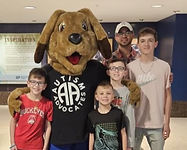

OUR ADVOCATES
The Autism Advocates community consists of individuals on the Autism spectrum, their families, and those that stand in solidarity with and advocate for Autism awareness, acceptance, and inclusion. Here at AutismAdvocates.org we are creating a space to come as you are, for community. We are shining a light on Autism and we are spreading support for the spectrum of possibilities. None of our journeys are the same so we are all a vital part in creating a culture that is aware, accepting and inclusive of people with varying abilities. We are building this community together!
About
OUR MISSION
Autism Advocates’ mission is to provide safety and community for children, families and individuals impacted by Autism. To create Autism awareness, understanding, and inclusion, while promoting the standard of all ability equality. To represent through merchandise and services, that all people of all abilities are of equal value. And to unconditionally love, embrace and support our differences.


OUR INITIATIVE
AQUATIC SAFETY + AUTISM = AQUATISM
Drowning is the leading cause of death among children with autism.
Aquatism is an adaptive water safety initiative designed specifically for individuals on the autism spectrum. Our mission is to create a national standard for inclusive aquatic safety and accessibility, one that embraces neurodiversity and ensures that every child, regardless of ability, has the tools and support they need to be safe and confident around water.
Adaptive supports are personalized strategies, tools, or environmental changes that help individuals with autism learn and succeed. In the water, this might include visual cues, sensory-friendly environments, communication aids, one-on-one instruction, or modified techniques tailored to a child’s specific needs.
By combining evidence-based practices, adaptive teaching strategies, and community collaboration, Aquatism aims to make pools, beaches, and aquatic spaces safer, more accessible, and more inclusive for all.
registration interest
inquiry form below






